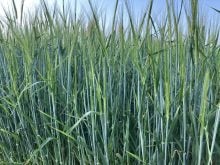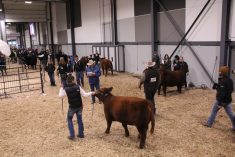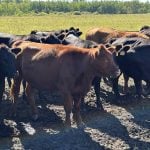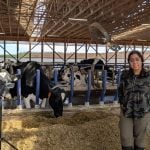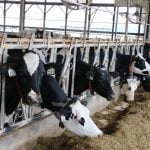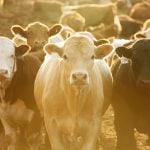Canadian and U.S. cattle inventories continued to contract at the start of 2022. Cattle supplies remained ample in the near term with large on-feed inventories but are expected to tighten in the second half of the year with a shrinking cow herd and smaller calf crop. Beef exports were remarkably strong in 2021 with record-high annual export values. While inflation has created concerns about demand erosion, beef demand remained solid in 2021. A tighter cattle supply outlook and strong beef demand is providing fundamental support to cattle prices, but producers continue to face challenges from high feed prices, supply chain disruptions and negative feedlot margins. The Russia-Ukraine war has led to trade disruptions in the Black Sea region and added greater volatility to grain prices.
- Market Intelligence Update from Canada Beef: U.S. importing more beef in 2022
- Market Intelligence Update from Canada Beef: Foodservice and importers suffer in China and Hong Kong as Omicron wave peaks
- Market Intelligence Update from Canada Beef: Canadian beef faces tough competition in Taiwan
Canadian cattle herd continued to contract
Total cattle and calves on January 1, 2022, were down 0.5 per cent to 11.1 million. Regionally, inventories were up 1.2 per cent to 2.9 million head in the East, but down 1.2 per cent to 8.2 million head in the West, due to extreme weather events ranging from record heat and drought conditions to severe flooding, limited forage supplies and increased feed costs.
Beef cow inventories were down for the fifth consecutive year by one per cent to 3.5 million head. This is the lowest level since 1990. The beef cow culling rate in 2021 is projected at 12.1 per cent, up from 11.4 per cent in 2020 and the long- term average of 11.4 per cent.
Read Also

What to know before you go to Agribition 2025
If you’re attending Agribition 2025, this is the place to find out about tickets, dates and what’s happening this year.
Beef heifers retained for breeding were down four per cent to 517,300 head, the lowest level since 2011. Most declines were in the West reflecting the impact of drought. Saskatchewan was down 8.5 per cent, Manitoba was down 6.2 per cent, Alberta was down 2.4 per cent, Atlantic provinces were down five per cent, Quebec was down 1.4 per cent; while Ontario was up 5.2 per cent and B.C. was steady.

The number of calves less than one year old were up 1.2 per cent to 3.8 million head, as imports of live calves increased by 36.3 per cent over the second half of 2021, compared with the same period in 2020.
Slaughter heifers and steers were down 2.3 per cent and 3.9 per cent, respectively. Drought conditions and high feed costs spurred sales of feeder and slaughter animals to the U.S. in the second half of 2021 and contributed to the lower inventory numbers.

Despite a shrinking cow herd, Canadian beef production has been supported by live cattle imports. Moisture conditions will be an important factor to watch for cattle trade in 2022. If drought abates in Canada but persists in the U.S., more cattle may be pushed north. Longer term, a shrinking cow herd and smaller calf crop in both Canada and the U.S. means tighten- ing North American cattle supplies down the road.
U.S. inventories down
U.S. total cattle inventories on January 1, 2022, were down two per cent from last year to 91.9 million head. Overall cattle numbers have declined 2.9 million head since the 2019 peak. Cattle inventories are now at the lowest level since 2015.
Beef cow inventories were down 2.3 per cent from last year. The U.S. cow herd has been shrinking for the last three years from 31.7 million in 2019 to 30.1 million head. Beef replacement heifer numbers were down 3.3 per cent to 5.6 million head. This is the fifth year of decline and the smallest beef replacement numbers since 2014. Given the current dry conditions across much of North America, there could be further contraction of the beef cow herd this year.

The 2021 calf crop was estimated at 35.1 million head, down one per cent from 2020. Cattle-on-feed inventories for all feedlots were steady with a year ago, suggesting near-term fed cattle supplies should remain stable. Feeder supplies outside of feedlots declined three per cent from last year with slaughter heifers and steers down 0.8 and 1.2 per cent, respectively, and calves under 500 lbs. were down 2.6 per cent, pointing towards tighter supplies in the second half of the year.
The current drought situation could support feeder sup- plies in the short term with more heifers and feeders going on feed sooner than later. The smaller calf crops and declining breeding female inventories are expected to limit feeder supplies in the coming years.
Record-high beef export value
In 2021, Canadian beef exports were up 20 per cent in volume and 37 per cent in value to 508,500 tonnes (product weight) valued at $4.4 billion. This is the second-highest volume on record, coming in after the 2002 high of 521,500 tonnes — and a new record for export value. The average export price rose 15 per cent from $7.66/kg in 2020 to $8.79/kg.
Export volumes increased to the U.S. (14 per cent), Japan (32 per cent), Mexico (54 per cent), China (92 per cent), Southeast Asia excluding Taiwan (103 per cent), South Korea (93 per cent), and the EU (65 per cent); but declined to Hong Kong and Macau (-42 per cent), Taiwan (-38 per cent) and the U.K. (-54 per cent).

Beef imports in 2021 were down 15 per cent in volume and seven per cent in value to 161,400 tonnes (product weight) valued at $1.42 billion. Import volumes increased from the EU (five per cent), Mexico (13 per cent), Brazil (nine per cent) and Argentina (641 per cent) and declined from the U.S. (-7.0 per cent), Australia (-47 per cent), New Zealand (-27 per cent) and Uruguay (-45 per cent).
Canada’s beef net trade volume was up 47 per cent to 347,000 tonnes, approaching the record high of 365,000 tonnes set in 2004. Net beef trade value was up 76 per cent from $1.7 billion to $3 billion, a new record high.
High retail prices and strong beef demand
Annual retail beef prices reached a record high at $21.37/kg in 2021, up five per cent from 2020. Despite higher prices, the Canadian retail demand index that measures a consumer’s willingness to pay is projected to be steady with 2020. At 118 (2,000=100), the index is the third-highest since 2016, and remains historically strong compared to the 1990s and early 2000s.
In February, monthly retail beef prices were up 16 per cent from a year ago at $23.33/kg. This was just $0.23/kg shy of the record high set in November 2021. While elevated beef price has created concerns about demand erosion, it should be noted that pork and poultry prices have also seen similar year-over-year increases. In February, retail pork prices were up 12 per cent from a year ago at $14.81/kg, and poultry prices were up 15 per cent at $8.04/kg.
The beef/pork price ratio at 1.58:1 and the beef/poultry price ratio at 2.90:1 remained within historical range as the beef/pork price ratio ranged between 1.39:1 to 1.67:1, and the beef/poultry ratio between 2.47:1 to 3.32:1 in the last three years. As long as price relationships with competing proteins remain within historical bounds, there should be limited substitutions and demand erosion as consumers both domestically and internationally have shown strong tolerance to higher prices.
Largest beef production since 2008
Strong domestic and export demand for beef supported Canadian beef production in 2021. Canadian beef production (includes live slaughter exports and offal) is projected to be up 5.4 per cent from a year ago at 3.6 billion pounds in 2021, reaching the highest level since 2008. Domestic beef production was up 7.3 per cent at 3.1 billion pounds, while live slaughter exports were down 7.7 per cent at 403 million pounds.
Federally inspected cattle slaughter was up 6.6 per cent from 2020 at 3.3 million head, the largest number since 2006. Canadian steer carcass weights reached the record set in 2016 at 919 pounds, up two pounds from 2020.

Packing plant utilization rates averaged 94 per cent in 2021, up from 89 per cent in 2020 and the long-term average of 79 per cent. Weekly utilization exceeded 100 per cent in 14 out of 52 weeks, mostly in the third quarter, as packers added Saturday kills.
In the first quarter of 2022, year-to-date federally inspected slaughter is up two per cent from a year ago.
Fed cattle slaughter was up two per cent from last year. The increase was driven by the West (three per cent), while the East is down four per cent. Non-fed cattle slaughter was up three per cent. The increase is driven by larger cow slaughter in the East (25 per cent), while cow slaughter in the West was down two per cent as packers prioritized fed cattle slaughter. Packer utilization rates remain high in 2022 and will be required to work through the current inventories of cattle on feed.
Elevated and volatile feed grain prices
Lethbridge barley prices traded steady between $440-$450/ tonne in the first quarter and up 41 per cent from a year ago in March. Ontario corn prices surged 16 per cent from $302/tonne in January to $352/tonne in March to be 24 per cent higher than a year ago. Similar in the U.S., Omaha corn surged 20 per cent from CDN$302/tonne (US$6.08/bushel) in January to CDN$360/tonne (US$7.23/bushel) to be 37 per cent higher than a year ago.

The March outlook for the 2022-23 crop year calls for a 40 per cent increase in Canadian barley supply and a one per cent increase in U.S. corn crop, assuming a return to normal weather conditions and trend yields. While this could add downward pressure on North American feed prices, the Russia-Ukraine crisis significantly increased the uncertainty in grain supply and trade flow in the global market. As exports in the Black Sea region are disrupted, USDA reduced the Ukraine corn export projection by 18 per cent (six million tonnes) in March. The sharp decline in Ukrainian corn exports combined with geopolitical uncertainty has seen grain prices surge.
Russia and Ukraine are also major contributors to global oil trade and major suppliers of fertilizers. As fuel prices continue to rise, surcharges for grain shipments are also increasing. Higher fertilizer prices are bound to increase production costs for grain.
Cattle prices
Fed cattle prices struggle with weak basis
Alberta fed cattle prices strengthened from $160/cwt in January to $163/cwt in March, up nine per cent from a year ago. Despite the increase, Alberta fed prices remained at a discount to Ontario prices as ample market-ready inventories in Western Canada, coupled with high feed cost and supply chain disruptions, pushed feedlots to market cattle sooner rather than later.
Ontario fed steer prices traded steady at $173/cwt in the first quarter and up 21 per cent from a year ago in March. Ontario fed prices have been on a premium to Alberta since June 2021 with the spread widened from $4/cwt in June 2021 to $13/cwt in January 2022 before narrowing to $11/cwt in March.

The Alberta to Nebraska cash-to-cash basis weakened from -$14/cwt in January to -$20/cwt in February before rebounding to -$13/cwt in March. While fed cattle exports to the U.S. were up 28 per cent from a year ago in January, border blockades in late January to mid-February created uncertainty and limited U.S. buying interest in Canadian cattle.
Feedlot losses are historically large. Based on cash prices, the Canfax Trends report estimated that feedlots were losing $314- $387/head on yearling steers and heifers that were placed into the feedlot during September and sold in February.
Alberta and Saskatchewan cattle-on-feed inventories on March 1, 2022, totalled 1.1 million head, nine per cent larger than last year and 13 per cent larger than the five-year average. Feedlot placements have been below year-ago levels since October, with the October through February placed numbers down seven per cent from the previous year. Ample on-feed inventories should continue to support cattle supplies in the near term, but supplies could tighten in the later part of the year as placements decline.
Cow prices seasonally strong
Cow prices were supported by seasonally strong trim prices and reduced imports of manufacturing beef. U.S. 85 per cent trim prices were up 30 per cent from last year in the first quarter. Meanwhile, beef imports from non-NAFTA countries were down 17 per cent in 2021.
Alberta D2 cow prices climbed 23 per cent from January to $94/cwt in March, which was eight per cent higher than last year, and the strongest price for March since 2017. The Alberta cow prices have been at a discount to the Ontario prices since February 2022, and the U.S. prices since July 2021.

From January to March, Ontario D2 cow prices surged 32 per cent to $100/cwt, which was 33 per cent higher than last year and seven per cent ($6/cwt) higher than the Alberta price. During the same period, U.S. utility cow prices were up 24 per cent to CDN$106/cwt (US$83/cwt), which was 33 per cent higher than last year and 29 per cent (CDN$12/cwt) higher than the Alberta price.
Drought conditions and limited forage supplies pushed more cows to the market last fall. Cow marketings were up 11 per cent in the fourth quarter of 2021, with exports up seven per cent and slaughter up 13 per cent. Cow slaughter in the first quarter of 2022 was up four per cent from a year ago, while cow exports were down one per cent in January.
Feeder prices steady to stronger than last year
Alberta 550-lb. steer prices increased four per cent from January to $232/cwt in March, which is slightly below year- ago levels at $231/cwt. Alberta 850-lb. steer prices traded steady at around $188/cwt in the first quarter, and up six per cent from last year in March.
Ontario feeder prices were pressured by the sharply higher corn prices. Ontario 550-lb. steer prices were down two per cent from January to $223/cwt in March, but remained two per cent above year-ago levels. Ontario 850-lb. steer prices were down one per cent from January to $190/cwt in March, but remained seven per cent above year-ago levels.

The Alberta 850-lb. steer cash-to-futures basis rebounded from a low of -$27/cwt in December to -$8/cwt in March. This is historically weak compared to +$6/cwt in March 2021 and the five-year average of -$6/cwt.
Canadian feeder cattle exports to the U.S. totalled 13,480 head in January, 3.5 times the volume of a year ago. Feeder imports in January were down 23 per cent at 20,670 head but kept Canada in a net import position. Larger exports combined with reduced imports will tighten fed cattle sup- plies going into the second half of the year.
Replacement ratios
The lower the replacement ratio, the fewer dollars the feed- lot must pay to replace a fed animal with a feeder; conversely, a higher ratio means the feedlot must pay more per pound to replace those animals. Consequently, a higher ratio has negative implications on feedlot profitability as more dollars are spent placing new cattle.
From Q4 2021 to Q1 2022, the replacement ratio trended one to eight per cent higher in the West, but one to six per cent lower in the East except for yearling steers (+1.0 per cent). Compared to Q1 2021, the ratios were one to nine per cent lower in the West and 12 to 17 per cent lower in the East.




